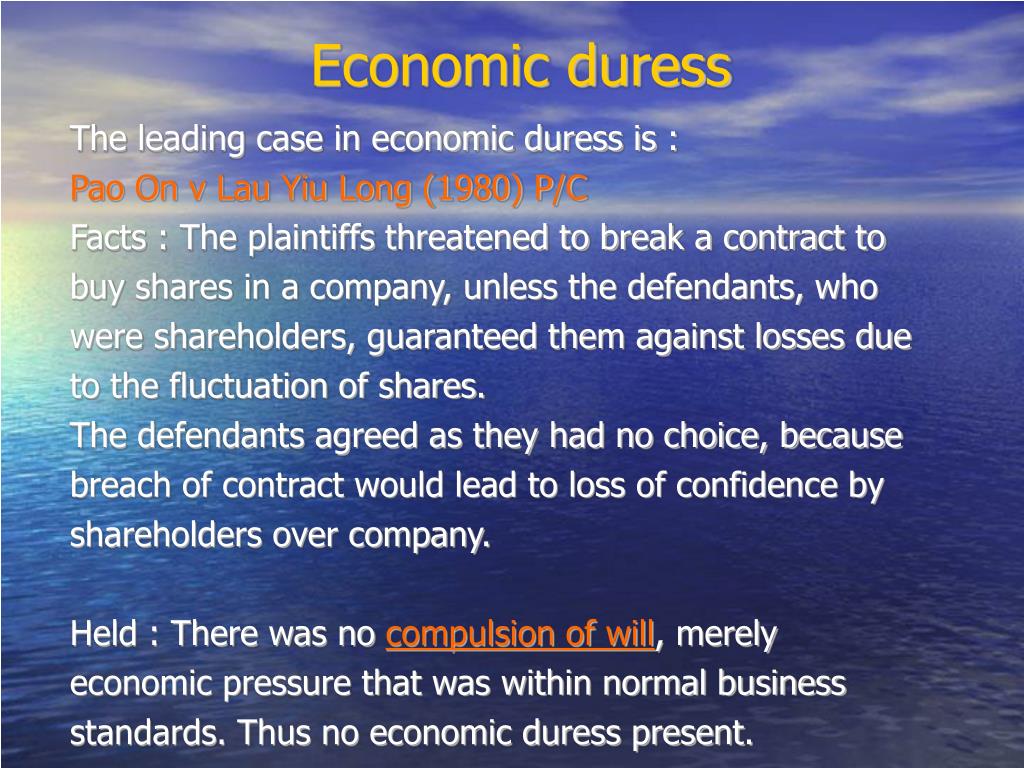
A person claiming defense of duress must prove that the other party threatened them or their goods to enter into an unlawful contract. Physical Duress : It is the threat either on a person or goods. Duress under contract broadly covers the following: Parties should rescind any wrongful act by the threat to compel manifestation. A contract under duress is voidable and stands still in the court. There must not be any defendant's benefit in action, and their involvement is mere because of coercion.ĭuress under contract arises when one party under contract is substantially powerful than the other and takes undue advantage of the position to do or force the other party to do any action without their consent.

The threat must be prompt and unavoidable. The threat must be greater than the loss that the action will cause. The threat must be significant, for example, harm, injury, or death. An act can be considered as a defense under duress if the following requirements are followed: For example, a company's chartered accountant is forced on a gunpoint to sign a no-objection certificate before auditing the financial statement as true and fair. If the nurse gets arrested for stealing medicines from the pharmacy, the nurse can use the defense of necessity arising out of the critical situation.ĭefense of Duress : It is an illegal activity conducted due to coercion. For example, a hospital nurse is coerced to pick medicines from a pharmacy during an emergency where the patient is in critical condition. However, both can act as preventive defenses during jurisdiction.ĭefense of Necessity : It is conducting an illegal activity to prevent harming another person. For the legislative definitions of circumstances of family violence, and evidence of family violence see sections 34V and 34W of the Evidence Act 1929 (SA).Defense of duress sometimes creates conflict with the defense of necessity.

If a defendant asserts that the offence occurred in circumstances of family violence, the questions of whether the defendant reasonably believed that a particular threat would be carried out, or whether the defendant reasonably believed that particular conduct was the only reasonable way a particular threat could be avoided, or whether the particular conduct was objectively a reasonable response to a particular threat, are to be determined having regard to any evidence of family violence admitted during the course of trial. Any other offence as prescribed by the associated regulations.Aiding, abetting, counselling ot procuring the commission of murder or.Conspiring or soliciting to commit murder.It is a defence to a charge of an offence (other than a prescribed offence*) if at the time of carrying out the conduct constituting the offence, the defendant reasonably believed that a threat had been made that would be carried out unless: There is a subjective and objective test involved in assessing this defence.ĭuress cannot be a defence to murder AC 653].įor offences allegedly committed on or after 1 February 2021 The common law defence remains available in respect of offences allegedly committed prior to 1 February 2021.Ī defendant may raise the defence of duress where the immediate threat of death or serious personal violence was so great that it overcame the defendant's resistance to carrying out the criminal act.


A new statutory defence of duress exists in certain circumstances from this date. On 1 February 2021, the common law defence of duress was abolished due to the insertion of section 14B to the Criminal Law Consolidation Act 1935 (SA).


 0 kommentar(er)
0 kommentar(er)
